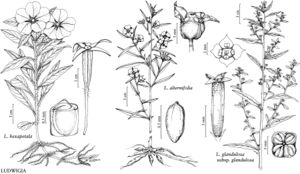Ludwigia alternifolia
Sp. Pl. 1: 118. 1753.
Roots fusiform, fascicled, thickened, epidermis splitting or peeling near base. Stems subterete or somewhat angled, with narrow raised lines or wings decurrent from leaf-axils, 40–150 cm, well branched in distal 1/2, glabrous or sparsely to densely strigillose. Leaves: stipules narrowly deltate, 0.05–0.2 × 0.05–0.1 mm; petiole 0.1–0.3 (–0.7) cm; blade lanceolate-elliptic, (0.6–) 2–12 × (0.3–) 1–1.5 (–2.5) cm, base attenuate, margins entire, apex acute, surfaces strigillose throughout or glabrate with strigillose veins; bracts often reduced and more linear. Inflorescences leafy racemes, flowers solitary in leaf-axils; bracteoles linear-lanceolate, 1–2.5 mm, margins entire, apex acute or subacuminate, glabrous or with scattered hairs, attached near base of ovary. Flowers: sepals narrowly ovate-deltate, (6–) 6.5–9.5 × 4–6.5 mm, margins entire, apex acute to obtuse, surfaces strigillose, sometimes mixed with villous hairs, or glabrate; petals cordate, 10–14 ×8–12 mm, base attenuate, apex emarginate; filaments opaque white, awl-shaped, 1–3 mm, anthers 1–1.7 × 0.6–0.8 mm; ovary subcuboid to globose, 2.5–4 ×2.5–3.5 mm; nectary disc slightly elevated on ovary apex, 0.8–1.5 mm diam., 4-lobed, ringed with soft, curly hairs or glabrous; style 1.5–2.4 mm, glabrous, stigma light yellow, capitate to hemispherical, 1–1.3 × 1.4–2 mm, shallowly 4-lobed, not or scarcely exserted beyond anthers. Capsules subcuboid to squarish globose, 4–6 (–7) × 4–6 mm, 4-angled and 4-winged, wings 0.3–1.5 mm wide, pedicel 2–7 mm. Seeds light-brown, oblong to reniform, 0.5–0.8 × 0.2–0.4 mm, surface cells elongate transversely to seed length. 2n = 16.
Phenology: Flowering summer–early fall.
Habitat: Swamps, damp, peaty places, roadside ditches, margins of cultivated fields.
Elevation: 0–1800 m.
Distribution
Ont., Que., Ala., Ark., Colo., Conn., Del., D.C., Fla., Ga., Ill., Ind., Iowa, Kans., Ky., La., Md., Mass., Mich., Miss., Mo., Nebr., N.H., N.J., N.Y., N.C., Ohio, Okla., Pa., R.I., S.C., Tenn., Tex., Vt., Va., W.Va., Wis.
Discussion
Ludwigia alternifolia is widespread and common in the eastern half of the flora area, as far west as Ontario in Canada, eastern Colorado, and Texas.
Ludwigia macrocarpa Michaux 1803 is a superfluous, illegitimate name for L. alternifolia. Rhexia linearifolia Poiret was originally described as a species of Melastomataceae, but the description is superficially similar to Ludwigia and has often been included in synonymy with L. alternifolia. The type of R. linearifolia has not been located or studied.
Selected References
None.
